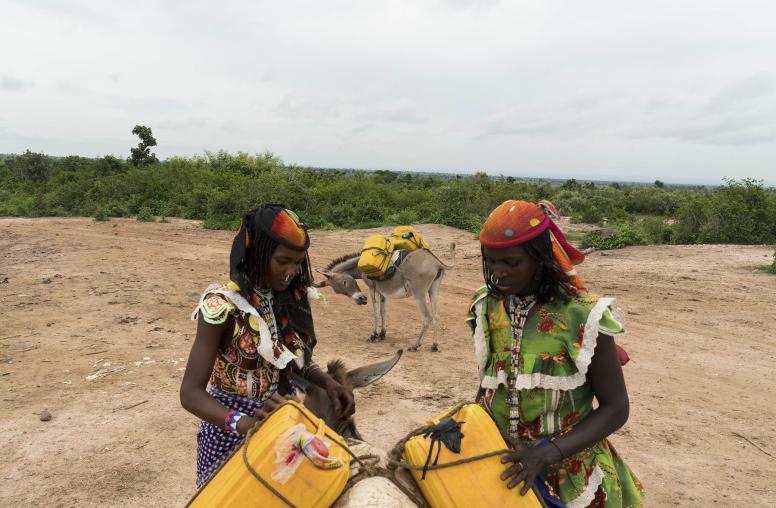Nigeria: Conflict in the Middle Belt: Oge Onubogu Testimony
Testimony before the Tom Lantos Human Rights Commission
Congressman Hultgren, Congressman McGovern, and members of the Commission, thank you for convening this hearing today on Nigeria and for the opportunity to testify. The views I express here are my own and do not represent those of the U.S. Institute of Peace (USIP).

It is an honor to appear before you today and to be joined in the audience by a group of influential civic and religious Nigerian leaders who are working in partnership with the U.S. Institute of Peace to find a lasting resolution to violent conflicts in their country. They have come together to form a Senior Working Group and one of the group's current efforts is to assist Nigerian government officials in addressing the root causes of the Boko Haram insurgency and other unrest in Nigeria, including deadly clashes between herders and farmers.
I want to thank you for organizing this hearing on this important, but under-reported conflict that now threatens to undermine the gains from U.S.–Nigeria partnerships and investments over the years in reducing violent conflict in Africa’s most populous country.
Tensions between nomadic cattle herders and more settled farming communities have a long history in Nigeria's north and along the country's Middle Belt. In recent years, what were once recurrent, low-level clashes mostly confined to these areas have spiraled into a deadly crisis that is inflaming religious as well as ethnic hostilities locally and nationally.
The frequency and intensity of these clashes has increased. Although the Boko Haram insurgency is still a threat, more casualties last year were tied to pastoral conflicts than to the extremist group—470 people were killed in cattle rustling incidents and 1,425 killed in clashes between farmers and herders. This conflict over land and natural resources has drawn little notice internationally and urgently needs more attention from Nigeria’s federal government.
Ultimately, these conflicts between farmers and herders are entirely predictable and can be prevented. The trajectory of this crisis has been documented by many scholars who have followed the history of the conflict in Nigeria in recent times. The geography of the violence can be traced and its direction can be anticipated if the appropriate government security agencies have effective early warning and rapid response mechanisms.
The trends and drivers of the conflict are also well-documented. Within Nigeria, the population growth and the expansion of farms have blocked many traditional grazing routes used by herders moving south as the Sahara Desert advances in northern Nigeria. Corrupt politicians have grabbed choice pieces of land. Environmental change in neighboring countries, such as the shrinkage of Lake Chad, has sparked an influx of foreign herders whose lack of familiarity with Nigerian populations often sparks violent misunderstandings. The crisis is also fueled by other conflict in the Lake Chad Basin and Sahel regions that has forced many nomadic cattle herding populations to flee areas of Mali and Niger where perennial conflict has made it difficult for them to freely graze their cattle.
Given these dynamics and trends, coordinated efforts are required at the local, state, national, and regional levels to end this violence.
The Senior Working Group recently conducted focus group discussions to understand the current trends of farmer-herder conflicts in Plateau state. These discussions revealed that while some early warning systems supported by the state government and civil society organizations exist, the capacity of justice and security actors to effectively utilize these systems to address early warning signs and respond to violent conflict is limited. In the absence of a well-coordinated national response, it is up to the local and state governments to revive local mechanisms for conflict resolution so that conflicts are not allowed to escalate into catastrophic events. USIP citizen surveys conducted earlier this year in Plateau and Borno states found that in situations of conflict, citizens would prefer to first seek help and advice from their traditional or community leaders.
Strengthening coordination between local communities and state justice and security actors, including the police and judiciary, can help state governments prioritize preventive measures. This coordination can be used to establish new or strengthen existing local peacebuilding and reconciliation mechanisms, especially within rural communities in areas most affected by this conflict. These efforts should also be complemented by support to state justice and security actors to strengthen their capacity to prevent, respond, and prosecute violent conflict.
Pastoral conflicts in Nigeria today are perhaps the most extensive territorially, as they affect states in all six geo-political zones of the country. This crisis has also provided a cover for other forms of criminal activities such as cattle rustling, rural banditry, and kidnapping.
Viable solutions to farmer-herder conflicts in the Middle-Belt would require looking beyond the region to understand how this conflict manifests itself in other parts of the country.
According to reports from local researchers in Nigeria, Zamfara state in the North West has recorded an equal if not higher number of casualties from pastoral conflicts. However, this conflict does not receive the same level of media coverage within Nigeria because it is predominantly a conflict between Muslim farmers and herders, and does not fit into the prevailing local media stereotype of Christian-Muslim conflicts.
The fact that many farmer-herder clashes in the Middle-Belt are between predominantly Christian farming communities and mostly Muslim nomadic cattle herders exacerbates existing ethno-religious hostilities. Given the historical deficit of trust between Christians and Muslims in Nigeria, viewing the current farmer-herder crisis in the Middle-Belt as an ethno-religious conflict that is distinct from other similar farmer-herder attacks across the country inflames social tensions and overshadows critical discussion about the harmful impacts of this conflict on Nigeria’s agricultural economy.
The combined effects of competition for land, crime, and poorly informed media speculations have resulted in a cycle of conflict with mass casualties suffered by both famer and herder communities.
Support for media training programs in coordination with local communities and relevant state government agencies can help to address the information gaps in media coverage of the Farmer-herder conflicts. Support to faith-based communities, community networks, and civic actors to develop balanced messaging about the crisis would help to shift the discussion from the identities and religious backgrounds of those involved in the conflict to focus more on identifying sustainable solutions to resolve conflict.
A solution to the conflicts between farmers and herders in Nigeria cannot be found in isolation of other countries in West Africa because pastoralists move across borders in the region. These pastoralists, who traditionally traveled without weapons, now resort to acquiring ammunition to protect their cattle from heavily armed and organized cattle rustling groups that roam across Nigeria’s north. A surge in cattle banditry has prompted herders who have never carried weapons before to arm themselves to protect their livelihoods. According to the Nigerian government, 70 percent of the 500 million illegal small arms and light weapons in West Africa are in Nigeria.
The context that frames the conflict between nomadic cattle herders and farming communities is global in nature, and efforts to address these challenges should draw from existing regional and sub-regional frameworks to articulate a collective regional response to the problem.
At the sub-regional level, the Economic Community of West African States (ECOWAS) has provided frameworks to improve livestock mobility across the region, such as the ECOWAS Transhumance Protocol of 1998 which allows herders to move their cattle across borders if they fulfil the conditions of the protocol, which include abiding by the laws of their host countries. Although these regional frameworks may not necessarily address the uniqueness of the situation in Nigeria, they can provide useful reference points for resolving conflict. Support to federal and regional agencies to review these existing frameworks can help inform steps towards dismantling the armed cattle rustling syndicates and tracking small arms and light weapons that have made their way into Nigeria through transnational criminal networks spread across the Sahel region.
Recent episodes of farmer-herder conflicts in Nigeria continue to suggest that efforts by the federal government to address the conflict are inadequate. The growing assertiveness of some state governors to solve these inter-communal farmer-herder clashes offers some cause for optimism and possible avenues to engagement. USIP and The Senior Working Group will be reviewing the role of the newly established state peacebuilding institutions in Plateau and Kaduna states to understand how these agencies can play a proactive role in monitoring violent conflict and preventing violence. These initiatives by state governments may contain low-level conflicts in some areas. However, without a coordinated state-federal effort—one that improves security, tackles corruption, and addresses the competition over natural resources—the violence already destabilizing parts of Africa’s most populous country and second largest economy will only widen and intensify.
Thank you, again, for the opportunity to testify today. I look forward to your questions.
The views expressed in this testimony are those of the author and not the U.S. Institute of Peace.



